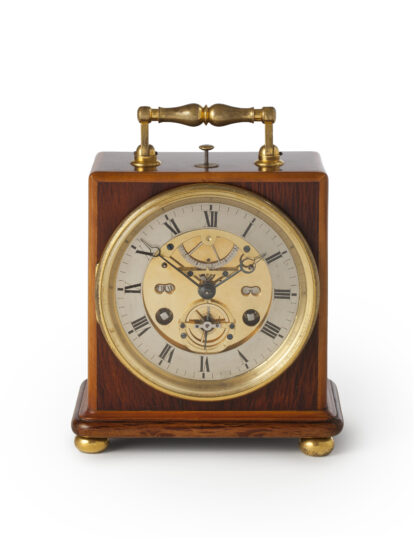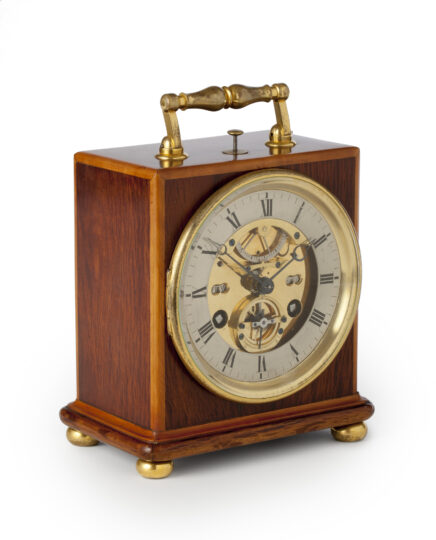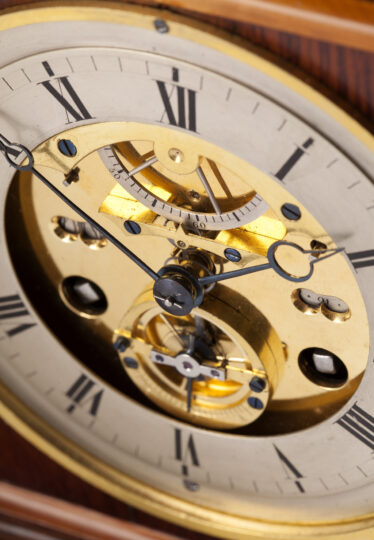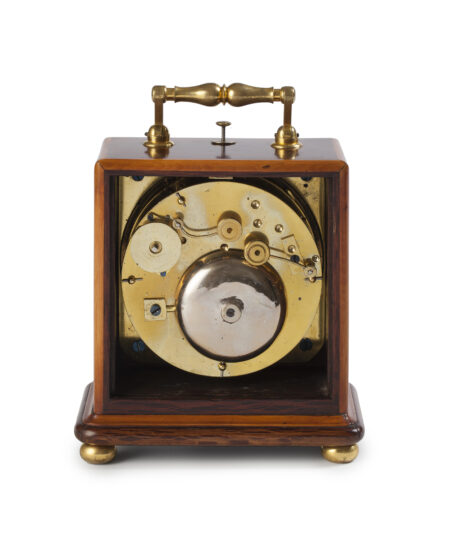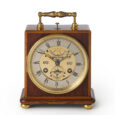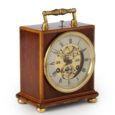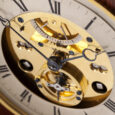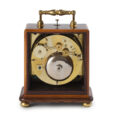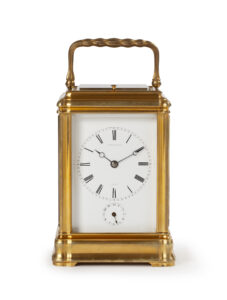UNUSUAL CARRIAGE CLOCK with visible escapement: Honoré Pons France
M&R119
UNUSUAL CARRIAGE CLOCK WITH VISIBLE ESCAPEMENT
Attributed to: Honoré Pons
Circa 1830
Frankrijk
Movement
The spring-driven eight-day brass movement consists of going and striking trains. The going train has MacDowal single-pin escapement, a variation on that of Deshayes, with hairspring balance and regulation, which is constructed visibly on the dial. The striking train indicates the hours fully and the half hours with a single stroke on a bell. The clock has trip repeat, activated by pushing a button on the case. In addition, the clock has an alarm. The clock is wound on the front.
Dial
The circular gilt-brass dial has a silvered-brass chapter ring with black Roman hour numerals, five-minute and minute divisions. The time is indicated by a pair of blued-steel Breguet hands. Below the middle is the jewelled hairspring balance with regulator pin. The direction for the regulation is indicated by the letters R and A (retard – slower and advance – faster). Above the middle is a rotating silvered brass seconds ring. There are two apertures to the left and the right of the middle, the left one to set the alarm time (with a watch key) and the one on the right for indicating the date. The balance is flanked by the winding arbors. The dial is protected by a faceted glass, set in a gilt-brass bezel.
Case
The birch-veneered case is embellished by maple-wood borders. The panel at the back can be opened with a catch, which gives access to the movement. The case is surmounted by a shaped gilt-brass carrying handle. The case rests on four gilt-brass bun feet.
Duration: 1 week
Height 13.5 cm
Width 12.5 cm
Depth 8 cm
Pons:
Honoré Pons de Paul was born in Grenoble. He went to Paris, Rue de la Huchette, as a pendulum maker. He was brought to St. Nicolas d’Aliermont by the Governor of the district of Lower Seine to set up the clock industry there. Clocks have been made by hand in St. Nicolas d’Aliermont for over a century. Pons settled there in 1807. He set up a machine department where machines were used that he had invented. Different types of these machines were exhibited in 1806 and are registered at C.A.M. in Paris: splitters, polishers and machines for making curves. He perfected percussion mechanisms, made an escapement with a circular balance for portable clocks. He exhibited in Rouen in 1809. About 1812 he succeeded in delivering one hundred movements a week in Paris where he had a depot on the Rue de la Barillerie and one at Séguy, Rue Poupée. He was awarded a silver medal in 1819, a gold medal in 1827, in 1839 and in 1844. He worked with Mathieu Croutte and Paul Rosetti. His Paris office was on Rue Cassette about 1840 to 1850.

